| Listing 1 - 10 of 148 | << page >> |
Sort by
|

ISBN: 9812793712 9789812793713 9810242360 9789810242367 Year: 2000 Publisher: Singapore [River Edge] N.J. World Scientific
Abstract | Keywords | Export | Availability | Bookmark
 Loading...
Loading...Choose an application
- Reference Manager
- EndNote
- RefWorks (Direct export to RefWorks)
The confinement mechanism of the quarks in QCD is one of the most challenging and open problems in physics. Confinement is a nonperturbative phenomenon, and a definite way to handle it has not yet been found in field theory. There are lattice calculations that can produce the low-lying states of the spectrum and "measure" many important physical quantities, but nevertheless the development of analytical techniques is of extreme importance for understanding the physics involved in confinement. In this respect it is important to test the results obtained directly from the theory (Bethe-Salpeter
Book
ISBN: 1282763563 9786612763564 9814295914 9781282763562 9789814295918 9789814295901 9814295906 Year: 2010 Publisher: Singapore Hackensack, NJ World Scientific
Abstract | Keywords | Export | Availability | Bookmark
 Loading...
Loading...Choose an application
- Reference Manager
- EndNote
- RefWorks (Direct export to RefWorks)
This is a comprehensive book which describes the three essential parts of what is known as 'Inertial Confinement Fusion': the way thermonuclear burn takes place in non-magnetized, magnetized and fusion-fission hybrid assemblies; the pulse power ignition technology (nuclear, electrical, optical and chemical); and, the applications of inertial confinement fusion technology for peaceful nuclear energy on Earth and in space. An integrated single text of such extensive technical width is a rare find, and younger generations of nuclear engineers any physicists will appreciate this book as a companio
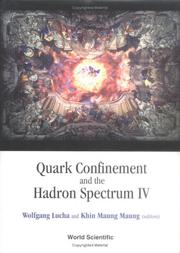
ISBN: 981277856X 9789812778567 9789810245672 981024567X 9789812778567 981024567X Year: 2002 Publisher: River Edge, N.J. World Scientific
Abstract | Keywords | Export | Availability | Bookmark
 Loading...
Loading...Choose an application
- Reference Manager
- EndNote
- RefWorks (Direct export to RefWorks)
Quark confinement --- Hadrons --- Quantum chromodynamics --- Confinement of quarks --- Quarks
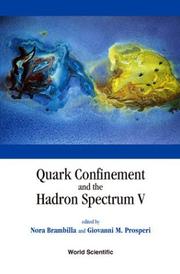
ISBN: 1281906018 9786611906016 9812704264 9789812704269 981238393X 9789812383938 9781281906014 6611906010 Year: 2003 Publisher: River Edge, NJ World Scientific
Abstract | Keywords | Export | Availability | Bookmark
 Loading...
Loading...Choose an application
- Reference Manager
- EndNote
- RefWorks (Direct export to RefWorks)
This book provides an update on our understanding of strong interaction, with theoretical and experimental highlights included. It is divided into five sections. The first section is devoted to the investigations into and the latest results on the mechanism of quark confinement. The second and third sections focus respectively on light and heavy quarks (effective field theories, Schwinger-Dyson approach and lattice QCD results). The fourth section deals with the deconfinement mechanism and quark-gluon plasma formation signals. The last section presents highlights of experiments, new physics be
Quark confinement --- Hadrons --- Quantum chromodynamics --- Confinement of quarks --- Quarks
Book
ISBN: 1634835387 9781634835381 1634835301 9781634835305 Year: 2015 Publisher: New York
Abstract | Keywords | Export | Availability | Bookmark
 Loading...
Loading...Choose an application
- Reference Manager
- EndNote
- RefWorks (Direct export to RefWorks)
Solitary confinement --- Juvenile detention --- United States.
Book
Year: 2019 Publisher: Gothenburg Kriterium
Abstract | Keywords | Export | Availability | Bookmark
 Loading...
Loading...Choose an application
- Reference Manager
- EndNote
- RefWorks (Direct export to RefWorks)
"In inter-war Sweden, the psychiatric diagnosis of psychopathy served as a controversial but powerful tool for the management of people who failed to live up to contemporary civic ideals. The diagnosis was based on theories of a broad spectrum of biologically-based disorders in the borderland between normality and actual mental illness. The disturbances were assumed to manifest themselves as, for example, homosexuality, hysterical attacks, emotional coldness, mythomania, or restlessness.Another controversial diagnosis was paranoia querulans or querulous paranoia, a disease that was linked to the emergence of the modern state and its rule of law, and thought to manifest itself mainly in hyperbolic complaints against supposed wrongdoings. Thus, the disorder implicated an excessive use of one's civil rights. A particular dilemma related to this disease was that the kind of behaviour that had usually led to the diagnosis and subsequent psychiatric confinement, namely a ardent manner of writing letters to public authorities, was precisely what was required for discharge.In De samhällsbesvärliga (The Social Troublemakers), historian of science and ideas Annika Berg examines how patients described as psychopaths or querulants could negotiate for discharge with doctors and authorities in 1930s and 40s Sweden. This was a period in time when the system of psychiatric care in Sweden was greatly expanded in answer to a perceived shortage, but was also transformed into a somewhat more open apparatus with possibilities to apply for preliminary discharge and other forms of outpatient solutions. It was also a time when psychiatry was under attack from different quarters, and psychiatrists were accused of using flexible diagnoses such as psychopathy to confine people wrongly. Against this backdrop, how did the management of psychopaths and querulants fit with contemporary ideals of citizenship and democracy? How did the patients view themselves? And how were negotiations in individual cases affected by notions of, for example, class, gender and sexuality?"
Psychiatry --- Psychopathy --- Paranoia querulans --- Diagnoses --- confinement --- intersectionality
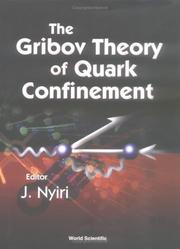
ISBN: 1281956589 9786611956585 9812811028 9789812811028 9781281956583 9789810247096 9810247095 Year: 2001 Publisher: River Edge, N.J. World Scientific
Abstract | Keywords | Export | Availability | Bookmark
 Loading...
Loading...Choose an application
- Reference Manager
- EndNote
- RefWorks (Direct export to RefWorks)
V N Gribov, one of the founders of modern particle physics, shaped our understanding of QCD as the microscopic dynamics of hadrons. This volume collects his papers on quark confinement, showing the road he followed to arrive at the theory and formulating the theory itself. It begins with papers providing a beautiful physical explanation of asymptotic freedom based on the phenomenon of antiscreening and demonstrating the inconsistency of the standard perturbative treatment of the gluon fields (Gribov copies, Gribov horizon). It continues with papers presenting the Gribov theory according to wh
Quark confinement. --- Quarks. --- Particles (Nuclear physics) --- Partons --- Quark-gluon interactions --- Confinement of quarks --- Quarks
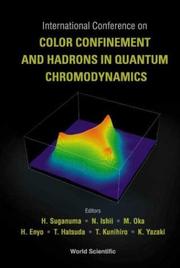
ISBN: 1281898864 9786611898861 9812702849 9789812702845 9812387811 9789812387813 9781281898869 Year: 2004 Publisher: [River Edge] New Jersey World Scientific
Abstract | Keywords | Export | Availability | Bookmark
 Loading...
Loading...Choose an application
- Reference Manager
- EndNote
- RefWorks (Direct export to RefWorks)
This book makes a global survey of nonperturbative aspects of quantum chromodynamics (QCD) from the viewpoints of mathematical, elementary-particle and hadron physics, including recent lattice-QCD results. It presents current, important progress in the following areas: the quark confinement mechanism, dynamical chiral-symmetry breaking, topologies in QCD (instantons, monopoles, vortices), SUSY QCD, nonperturbative methods (1/Nc, ladder QCD, AdS/CFT), QCD phase transition at finite temperature and density, quark-gluon plasma, and so on. For recent topics, the book also includes the experimental
Book
ISBN: 1503631249 9781503631243 9781503614673 9781503631236 Year: 2022 Publisher: Stanford, California
Abstract | Keywords | Export | Availability | Bookmark
 Loading...
Loading...Choose an application
- Reference Manager
- EndNote
- RefWorks (Direct export to RefWorks)
Twenty to forty percent of the US prison population will spend time in restricted housing units—or solitary confinement. These separate units within prisons have enhanced security measures, and thousands of staff control and monitor the residents. Though commonly assumed to be punishment for only the most dangerous behaviors, in reality, these units may also be used in response to minor infractions. In Surviving Solitary, Danielle S. Rudes offers an unprecedented look inside RHUs—and a resounding call to more vigorously confront the intentions and realities of these structures. As the narratives unfold we witness the slow and systematic damage the RHUs inflict upon those living and working inside, through increased risk, arbitrary rules, and strained or absent social interactions. Rudes makes the case that we must prioritize improvement over harm. Residents uniformly call for more humane and dignified treatment. Staff yearn for more expansive control. But, as Rudes shows, there also remains fierce resilience among residents and staff and across the communities they forge—and a perpetual hope that they may have a different future.
Prisoners --- Solitary confinement. --- carceral residents. --- correctional staff. --- interviews. --- prison reform. --- prisons. --- qualitative. --- reentry. --- restricted housing units. --- solitary confinement.
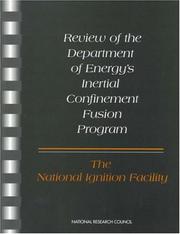
ISBN: 0309057787 9786610191420 1280191422 0309590469 0585193665 9780585193663 6610191425 9780309057783 Year: 1997 Publisher: Washington, D.C. National Academy Press :Copies available from Naval Studies Board
Abstract | Keywords | Export | Availability | Bookmark
 Loading...
Loading...Choose an application
- Reference Manager
- EndNote
- RefWorks (Direct export to RefWorks)
POLITICAL SCIENCE --- Public Affairs & Administration --- Inertial confinement fusion --- Physics --- Physical Sciences & Mathematics --- Nuclear Physics --- Government policy --- Inertial confinement fusion. --- United States. --- Fusion, Inertial confinement --- Inertial fusion --- Pellet fusion --- NIF --- Controlled fusion
| Listing 1 - 10 of 148 | << page >> |
Sort by
|

 Search
Search Feedback
Feedback About UniCat
About UniCat  Help
Help News
News